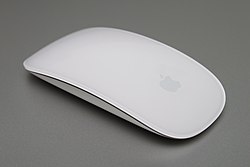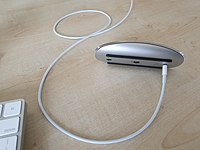Magic Mouse
 White and silver Magic Mouse | |
| Manufacturer | Apple Inc. Foxconn (contract manufacturer) |
|---|---|
| Type | Multi-touch clear acrylic surface with laser tracking mouse |
| Release date |
|
| Discontinued | 1st gen: October 13, 2015 |
| Connectivity |
|
| Power |
|
| Dimensions |
|
| Mass |
|
| Predecessor | Mighty Mouse |
| Related | Apple Wireless Keyboard Magic Keyboard Magic Trackpad 2 |
| Website | Magic Mouse |
The Magic Mouse is a multi-touch wireless mouse sold by Apple Inc. and manufactured by Foxconn. The first-generation Magic Mouse was released on October 20, 2009, and introduced multi-touch functionality to a computer mouse.[1][2] Taking after the iPhone, iPod Touch, and multi-touch MacBook trackpads, the Magic Mouse allows the use of multi-touch gestures and inertia scrolling across the surface of the mouse, designed for use with macOS.
The second-generation Magic Mouse (initially marketed as Magic Mouse 2) was released on October 13, 2015, removing the use of AA batteries, instead including a lithium-ion rechargeable battery, and a Lightning port for charging and pairing, and was later made fully compatible with iPadOS.[3]
Models[edit]
1st generation[edit]
The first generation Magic Mouse was released on October 20, 2009, and introduced multi-touch functionality. It connects wirelessly to a Mac computer via Bluetooth.[4] It is powered by two AA batteries, and operates using a solid-state laser tracking sensor like the previous-generation wireless Mighty Mouse. Apple includes two non-rechargeable batteries in the box. Until 2016, Apple sold a battery charger that included two rechargeable NiMH AA batteries, designed for use with Mac peripherals.
Like its predecessor, the Mighty Mouse, the Magic Mouse includes support for secondary click.[5] The Magic Mouse has been included with most desktop Mac computers since its introduction, including the iMac, iMac Pro, and third-generation Mac Pro, as well as being available as a standalone purchase.
The Magic Mouse borrows design elements from the preceding Apple Pro Mouse, notably its seamless "zero-button" design and translucent acrylic surface for 360-degree scrolling, replacing the rubber scroll ball on the Mighty Mouse. The mouse does not support left and right-clicking simultaneously, and also removes the ability to middle click without third-party software workarounds.[6]
2nd generation[edit]
The second generation Magic Mouse was introduced in October 2015, alongside the Magic Keyboard and second-generation Magic Trackpad. A space gray color was introduced with the iMac Pro in 2017, and was later made available as a standalone purchase.[7] iPadOS 13.4 introduced mouse support to iPads for the first time, and supports all functionality of the second generation Magic Mouse.
A variety of pastel colors were introduced in 2021 to match the colors of the M1 iMac.[8] Additionally, standalone purchases include a USB-C to Lightning cable, instead of USB-A to Lightning. The space gray color was replaced by a black color with a silver aluminum finish in 2022, which was originally only available bundled with the third-generation Mac Pro.[9] All colors of the second-generation Magic Mouse have been introduced alongside matching colors for various Magic Keyboard models.[7][9]
Criticism[edit]
1st generation[edit]
Initial reception to the Magic Mouse was mixed, with reactions to its inability to trigger Exposé, Dashboard, or Spaces, as its predecessor could, or to middle click.[10] Later versions of Mac OS X include gestures to open Mission Control, which incorporates functionality from Exposé, Dashboard, and Spaces. Other issues included the mouse's unstable connection to the first and second-generation Mac Pro models, and its low-profile design being uncomfortable & unergonomic was causing palm-aches, and hand cramping for some users.[11][12]
2nd generation[edit]
The Lightning charging port is located on the bottom of the mouse, rendering it unusable while charging. Even with multiple attempts to make the Magic Mouse usable whilst charging (most notably by Unnecessary Inventions), a software lock had disabled it. This was a design choice that was widely criticized by reviewers.[13][14][15] Critics have also noted the omission of Force Touch technology, compared to the second-generation Magic Trackpad.[13][14]
Gallery[edit]
See also[edit]
References[edit]
Citations[edit]
- ^ "Magic Mouse". Apple. Archived from the original on October 6, 2015. Retrieved December 1, 2009.
- ^ Topolsky, Joshua (October 20, 2009). "Apple's Magic Mouse: One Button, Multitouch Gestures, Bluetooth, Four-Month Battery Life". Engadget. Archived from the original on October 19, 2011. Retrieved October 25, 2009.
- ^ "Review: Apple's Magic Keyboard + Magic Trackpad 2 add precision and power, lose compatibility". Archived from the original on October 21, 2015. Retrieved October 20, 2015.
- ^ "Magic Mouse 1 will not scroll on l… | Apple Developer Forums". developer.apple.com. Archived from the original on July 20, 2022. Retrieved July 29, 2022.
- ^ "Apple Magic Mouse review – the cleverest mouse yet?". techradar.com. October 27, 2009. Archived from the original on July 11, 2017. Retrieved October 8, 2014.
- ^ "How to enable "middle" click of Apple's Magic Mouse?". Ask Different. Archived from the original on September 30, 2020. Retrieved July 29, 2022.
- ^ a b "Apple Now Selling Standalone Space Gray Magic Keyboard, Magic Mouse 2, and Magic Trackpad 2". MacRumors. Archived from the original on May 19, 2022. Retrieved July 1, 2022.
- ^ "Apple Starts Selling New iMac Accessories Separately". PCMAG. Retrieved September 26, 2022.
- ^ a b SEA, Mashable (March 9, 2022). "Apple launched a new Magic Mouse, and yes, it still charges from the bottom". Mashable SEA. Archived from the original on July 1, 2022. Retrieved July 1, 2022.
- ^ Loyola, Roman (October 21, 2009). "First Look: Apple Magic Mouse". Macworld. Archived from the original on March 6, 2012. Retrieved October 25, 2009.
- ^ "Bugs & Fixes: Magic Mouse Loses Its Way". Archived from the original on March 8, 2012. Retrieved March 4, 2010.
- ^ "Has anyone experienced ergonomic problems with the Magic Mouse?". Ask Different. Archived from the original on July 29, 2022. Retrieved July 29, 2022.
- ^ a b "Review: Apple's Magic Trackpad 2 and Magic Mouse 2 open new doors for Mac". AppleInsider. Archived from the original on December 12, 2015. Retrieved December 13, 2015.
- ^ a b "Apple Magic Mouse 2 review: Mouse unable to conjure up any innovation". Macworld. Archived from the original on December 17, 2015. Retrieved December 13, 2015.
- ^ "The Sad Reality of the Magic Mouse 2". Gizmodo. Archived from the original on August 24, 2017. Retrieved December 13, 2015.
Sources[edit]
- "The Sad Reality of the Magic Mouse 2". Gizmodo. Retrieved December 9, 2015.
- "Apple forgot to revolutionize the Magic Mouse's infamous charging port". The Verge. Retrieved October 25, 2021.


